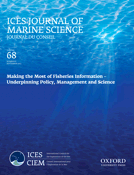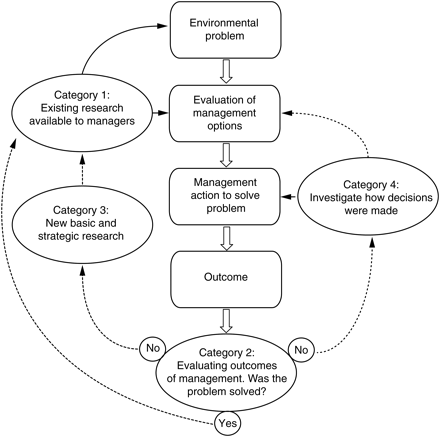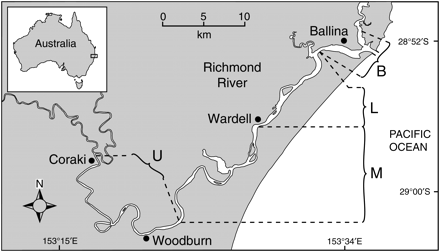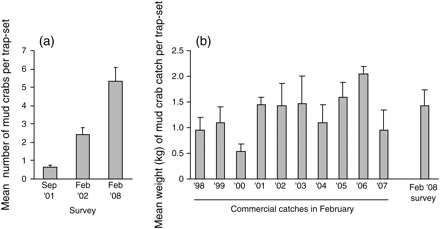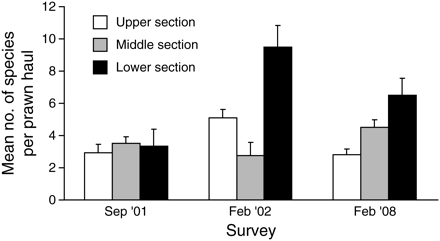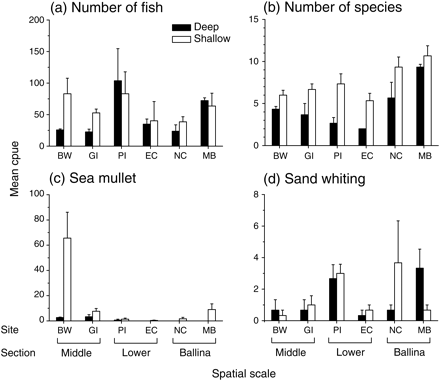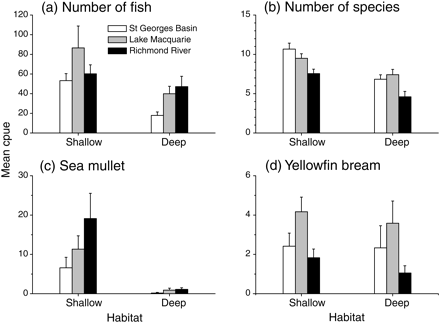-
PDF
- Split View
-
Views
-
Cite
Cite
Douglas Rotherham, William G. Macbeth, Steven J. Kennelly, Charles A. Gray, Reducing uncertainty in the assessment and management of fish resources following an environmental impact, ICES Journal of Marine Science, Volume 68, Issue 8, September 2011, Pages 1726–1733, https://doi.org/10.1093/icesjms/fsr079
Close - Share Icon Share
Abstract
The limitations of using information from commercial fisheries for assessing and managing resources and ecosystems are well known. Although fishery-independent data may overcome many such limitations, few studies have examined how incorporating data from different sources affects assessments and subsequent management decisions. Here, the value of integrating data from two types of sampling survey to assess the recovery of faunal populations following a severe fish-kill event in the Richmond River (New South Wales, Australia) in 2008 is evaluated. There is occasional large-scale mortality of fish and invertebrates in certain estuaries of eastern Australia following major flood events. In extreme cases, the management response involves closing an entire estuary to all fishing, to facilitate the recolonization and recovery of fish and other fauna. Decisions to resume normal fishing activities have environmental, economic, and social implications. Using lessons learned from a similar fish-kill event in 2001, it is shown how, in 2008, fishery-independent sampling, combined with improved sampling by commercial fishers, reduced uncertainty in decision-making and led to greatly improved socio-economic outcomes for stakeholders. The work highlights the need to examine the value of different sources of information to improve management decisions.Rotherham, D., Macbeth, W. G., Kennelly, S. J., and Gray, C. A. 2011. Reducing uncertainty in the assessment and management of fish resources following an environmental impact. – ICES Journal of Marine Science, 68: 1726–1733.
Introduction
In many parts of the world, the assessment and management of fish resources rely on fishery-dependent information, e.g. landings, catch per unit effort (cpue), and size and age compositions of catches. Nevertheless, because of well-known biases and limitations, such data are often unreliable or inappropriate for either traditional assessments of harvested species, or ecosystem-based approaches to management (Hilborn and Walters, 1992; Harley et al., 2001; Maunder et al., 2006; Cotter et al., 2009). Therefore, assessments and management decisions underpinned by fishery-dependent data are frequently confounded by uncertainty (Sissenwine, 1984; Ludwig et al., 1993; Charles, 1998). This problem has sometimes contributed to declines in fish populations through erroneous recommendations (Sinclair and Murawski, 1997; Maunder et al., 2006), and perhaps more commonly, through the inability or unwillingness of managers and policy-makers to act with precaution in the face of uncertain information and political pressure (i.e. the ratchet effect; see Ludwig et al., 1993).
Strategies for reducing uncertainty and improving decision-making in fishery management often call for the collection of more and better data (Rose and Cowan, 2003; Mace, 2004; Murawski et al., 2008). Fishery-independent data are commonly advocated (Pennington and Strømme, 1998; Maunder et al., 2006), along with improvements in the quality and quantity of fishery-dependent information (National Research Council, 2000). Yet, it is often unclear whether more or better data actually reduce uncertainty and lead to different or improved decisions. Management has failed and fish stocks collapsed despite substantial investments in the collection and integration of both fishery-dependent and fishery-independent data into state-of-the-art assessments (Walters and Maguire, 1996; Myers and Worm, 2003). Therefore, problems of uncertainty are not necessarily resolved by collecting additional data or improving scientific research (Ludwig et al., 1993; Johannes, 1998).
Underwood (1995, 1998) argued that more research was needed on the consequences of uncertainty in environmental management and decision-making. He examined relationships between ecological research and decision-making in response to environmental disturbances, and identified several categories of research that interact in their effects on management decisions (Figure 1). He argued that information in the available pool (category 1 research) sought by managers needing to solve a problem (e.g. declining cpue in a fishery) was often inadequate or uncertain because other types of important research were rarely, if ever, done. These included (i) examining the success or failure of management by treating management decisions as testable hypotheses using manipulative experiments (category 2 research, i.e. adaptive management experiments; Hilborn and Walters, 1981; Walters, 1986), (ii) developing novel, strategic programmes to provide new information when management fails to solve a problem (category 3 research), and (iii) investigating the processes of management and the procedures by which decisions are reached using information already available under category 1 (category 4 research).
Some relationships between different types of research and the management of an environmental problem as outlined by Underwood (1995, 1998). The four categories of research are: (i) available research sought by managers to solve a problem; (ii) research done to examine the success or failure of management by treating their decisions as testable hypotheses; (iii) novel, strategic research to provide new information when management fails to solve a problem; and (iv) research on the processes of management and the procedures by which decisions are reached using information provided under category 1. Management steps are connected by open arrows, solid arrows show the connections of research to management, and dotted arrows indicate feedbacks and interconnections among the research categories.
By doing more research under categories 2, 3, and 4, Underwood (1995, 1998) argued that the problems of uncertainty might eventually be resolved by providing the necessary information for more effective management of environmental problems. Unfortunately, there seems to have been little progress in these areas of research in either aquatic (Walters, 2007) or terrestrial (Gosselin, 2009) environments. Adaptive management experiments have proven difficult to implement (Walters, 2007), and there are few real-world examples of research into the process of decision-making. Hence, decisions about whether to make the most of existing information, invest in alternative sources of data, or allocate limited resources to management actions rather than the collection of data are often complex and contentious (Kelly and Codling, 2006; Hansen and Jones, 2008a, b; Murawski et al., 2008).
Here, we illustrate how elements of the research categories advocated by Underwood (1995, 1998) improved the assessment and management of a large fish-kill event in the Richmond River, New South Wales (NSW), Australia, in 2008. Using an adaptive approach incorporating lessons learned from a previous fish kill in 2001 (i.e. category 2 research), we show how new strategic research (i.e. category 3) led to an additional source of information (in category 1), so reducing uncertainty in decision-making and leading to better socio-economic outcomes for stakeholders. Our a posteriori evaluation of the different sources of data in assessing and managing large fish kills is an important step towards much-needed research into the process of decision-making about environmental issues (i.e. category 4 research), including the sustainability of fishery resources.
Case study: fish kills in the Richmond River, NSW
The Richmond River (28°52′S 153°34′E) is a large river (∼170 km long) on the north coast of NSW that flows into a wave-dominated barrier estuary (Roy et al., 2001) that is permanently open to the ocean. The river (surface area ∼19 km2) and its catchment (∼6850 km2) support valuable commercial and recreational fisheries together with agricultural production and tourism; these are of considerable social and economic importance to the region.
In early February 2001, a series of extreme storms in northern NSW caused widespread flooding throughout the Richmond River catchment. About 1 week later, there was a major fish kill in the lower reaches of the river on a scale rarely seen before in Australia (Macbeth et al., 2002; Walsh et al., 2004). The massive mortalities of finfish and invertebrates were attributed to the drainage of anoxic waters from floodplains, creeks, and riparian swamps into the main river channel. It was hypothesized that deoxygenation of slow-draining floodwaters was caused by strong solar radiation, high temperature, and the decay of floodplain and riparian vegetation (Slavich, 2001; Macbeth et al., 2002; Walsh et al., 2004). Although millions of fish and invertebrates were killed (Walsh et al., 2004), it appeared that many organisms had migrated or were flushed from the river during the flood (Macbeth et al., 2002).
Immediately following the fish kill (9 February 2001), the NSW Government closed the Richmond River and adjacent, inshore oceanic waters to all fishing. Hence, the management hypothesis (sensuHilborn and Walters, 1981; Underwood, 1995) was that removing commercial and recreational fishing pressures would enhance the recolonization of these areas by fish and invertebrates when the water quality improved. This hypothesis was not tested experimentally during the post-fish-kill monitoring owing to a lack of resources to achieve appropriate levels of replication. Similarly, it was not possible to carry out an experiment to test for the impact of the fish-kill event using an appropriate before–after–control–impact (BACI) design (Underwood, 1991), because there were insufficient “before” data available for either the Richmond River or other non-impacted (control) estuaries (Macbeth et al., 2002). The decision on when to reopen the commercial fishery relied solely on the monitoring of spatial and temporal patterns in the distribution and abundance of fish and invertebrate populations in the Richmond River after the fish kill (Macbeth et al., 2002).
Given the urgent need to implement a programme to monitor the recovery of the Richmond River, most of the sampling of fish and invertebrates was done by commercial fishers (instructed and supervised by scientific staff) using various commercial fishing gear, including gillnets, seines, and traps (see Macbeth et al., 2002, for detail). Following the closure of the river, post-fish-kill sampling surveys were carried out in mid- and late February 2001. These indicated that water quality was very poor and abundances of fish and crustaceans extremely low (Macbeth et al., 2002), so the fishing closure was extended pending the results of subsequent four-weekly surveys.
Parts of the Richmond River were eventually reopened to limited recreational or commercial fishing activities on 1 July 2001. A four-month survey was then implemented to assess the quality of recreational fishing following the partial lifting of the total closure (Steffe et al., 2007), additional to the four-weekly sampling surveys. Large catches were made during the survey of recreational fishing, along with favourable population assessments from the August 2001 sampling survey, so the river was fully reopened to normal fishing activities on 28 September 2001 (i.e. more than six months after the fish kill).
Lessons learned from the 2001 response to the fish kill
The response to the 2001 fish kill in the Richmond River involved successful collaboration among fishers, scientists, and other stakeholders in implementing a sampling programme to assess and monitor the recovery. Nevertheless, given the unprecedented nature of the fish kill and lack of appropriate data available before the impact, from either the river or any control estuaries, there was considerable uncertainty surrounding decisions about when to reopen the river to normal fishing activities. Anecdotal evidence from commercial and recreational fishers, and the broader community, indicated that the adopted precautionary approach to management had serious socio-economic implications. Many fishers, local businesses, and tourism operators suffered financial hardship as a result of the extended fishing closure. Therefore, there were important lessons in the assessment and management of this environmental impact (sensu category 2 research; Underwood, 1995) that could be used to improve environmental and socio-economic outcomes in the event of similar fish kills in future.
The first lesson was that the monitoring programme was too inflexible regarding when and where the sampling took place (Macbeth et al., 2002). As discussed above, the programme could not determine whether populations of fish and crustaceans in the river had recovered to pre-flood levels. Instead, it attempted to address the hypothesis that populations had recovered (or were recovering) to levels that could support the resumption of normal fishing activities. During the initial sampling surveys, however, there was high flood-induced turbidity in the river. As the four-weekly sampling surveys continued (and turbidity decreased), surface-set gillnet catches by day remained low, whereas those using other fishing methods indicated that populations were recovering. The fishers maintained this was because gillnetting was being done in the wrong places at the wrong time of day, given the improved water conditions (i.e. the catches would have been low even if there had been no fish kill). Indeed, extra daylight and night-time gillnetting some months into the programme (at sites selected by commercial fishers) confirmed the presence of large numbers of fish in the river despite poor catches during the regular daytime gillnetting (Macbeth et al., 2002). Therefore, it was recommended that in monitoring future fish-kill events, sampling by commercial fishers should be more flexible in terms of when and where it was done, to improve its relevance to the management questions being posed (Macbeth et al., 2002).
The second lesson was that regular fishery-independent surveys were required in estuaries and rivers of NSW to provide appropriate data on the status of populations of fish and crustaceans in times of relative health (Macbeth et al., 2002). It was recommended that new research be undertaken to develop reliable and robust sampling methodologies and regimes (i.e. category 3 research; Underwood, 1995) to allow appropriate comparisons should a fish kill (or other environmental impact) take place in future. This had potential benefits not only by reducing the uncertainty in decisions for managing impacts such as fish kills, but also in improving the overall assessments and management of estuarine fish resources in NSW (Macbeth et al., 2002).
Using lessons from 2001: assessing and managing a fish kill in 2008
In early January 2008, there was another severe flood-induced fish-kill event in the Richmond River. Processes contributing to the deoxygenation of floodwaters were the same as those implicated in the 2001 fish kill (see above). Further, testimony from fishers, scientists, and managers indicated that the 2008 fish kill was of a similar magnitude to that of 2001, i.e. that millions of organisms were killed. On 18 January, the river was closed to all fishing activities. We consider the 2001 and 2008 fish-kill events to have been comparable because they (i) were at similar times of the year, (ii) were caused by similar processes, and (iii) resulted in large-scale mortalities of fish and invertebrates that forced the closure of commercial and recreational fisheries.
Using lessons from 2001, the recovery assessment in 2008 proceeded quite differently. About one month after the closure, i.e. six weeks after the fish kill, two separate sampling surveys were carried out over a period of ∼one week. The first was by commercial fishers and is described here as fisher-dependent sampling, because the fishery per se was closed. All commercial fishers operating in the river were contracted to provide boats, sampling equipment, and expertise. During the 2001 event, in contrast, only a few commercial fishers participated in and benefitted financially from the monitoring programme.
Fisher-dependent sampling
Fisher-dependent sampling used local commercial-fishing methods (fish- and prawn-seining, crab- and eel-trapping, and gillnetting) throughout the lower Richmond River (Figure 2) to examine whether catch rates of fish and crustaceans were similar to those when the river was reopened to normal fishing after the fish kill in 2001. For the purposes of spatial and temporal comparisons, the lower Richmond River was partitioned into four distinct sections: Ballina (B), Lower (L), Middle (M), and Upper (U) sections (Figure 2). The various commercial fishing methods were used in some or all these sections (depending on suitability and practicality), with a sampling design similar to that used in 2001 (Table 1). The main differences in 2008 were (i) both surface set and demersal gillnetting were done at night, (ii) fish-seining was included, and (iii) fishers were allowed to apply their knowledge and experience in selecting the sampling sites.
Number of replicate sampling units (i.e. net-sets/hauls/trap-sets) for each of the fisher-dependent sampling methods used in the four sections of the Richmond River during February 2008.
| . | Section of Richmond River . | |||
|---|---|---|---|---|
| Fisher-dependent sampling method . | Ballina . | Lower . | Middle . | Upper . |
| Demersal gillnet | 3 | 3 | 3 | 3 |
| Surface gillnet | 3 | 3 | 3 | 3 |
| Boat-based demersal fish-seine | – | 2 | 1 | – |
| Boat-based demersal prawn-seine | – | 6 | 6 | 6 |
| Mud-crab trap | – | 20 | 20 | – |
| Eel trap | – | – | 20 | 20 |
| . | Section of Richmond River . | |||
|---|---|---|---|---|
| Fisher-dependent sampling method . | Ballina . | Lower . | Middle . | Upper . |
| Demersal gillnet | 3 | 3 | 3 | 3 |
| Surface gillnet | 3 | 3 | 3 | 3 |
| Boat-based demersal fish-seine | – | 2 | 1 | – |
| Boat-based demersal prawn-seine | – | 6 | 6 | 6 |
| Mud-crab trap | – | 20 | 20 | – |
| Eel trap | – | – | 20 | 20 |
Number of replicate sampling units (i.e. net-sets/hauls/trap-sets) for each of the fisher-dependent sampling methods used in the four sections of the Richmond River during February 2008.
| . | Section of Richmond River . | |||
|---|---|---|---|---|
| Fisher-dependent sampling method . | Ballina . | Lower . | Middle . | Upper . |
| Demersal gillnet | 3 | 3 | 3 | 3 |
| Surface gillnet | 3 | 3 | 3 | 3 |
| Boat-based demersal fish-seine | – | 2 | 1 | – |
| Boat-based demersal prawn-seine | – | 6 | 6 | 6 |
| Mud-crab trap | – | 20 | 20 | – |
| Eel trap | – | – | 20 | 20 |
| . | Section of Richmond River . | |||
|---|---|---|---|---|
| Fisher-dependent sampling method . | Ballina . | Lower . | Middle . | Upper . |
| Demersal gillnet | 3 | 3 | 3 | 3 |
| Surface gillnet | 3 | 3 | 3 | 3 |
| Boat-based demersal fish-seine | – | 2 | 1 | – |
| Boat-based demersal prawn-seine | – | 6 | 6 | 6 |
| Mud-crab trap | – | 20 | 20 | – |
| Eel trap | – | – | 20 | 20 |
Spatial partitions of the lower Richmond River (NSW, Australia) used for the 2008 post-fish-kill sampling surveys. The four sections are Ballina (B), Lower (L), Middle (M), and Upper (U).
Fishery-independent sampling
The second type of sampling survey was by Government researchers using multimesh gillnets specially designed to catch a wide size range and diversity of fish fauna, including categories not caught in commercial gillnets, e.g. undersized fish (Rotherham et al., 2007; Gray et al., 2009). Although much pilot work had been done on the development of fishery-independent sampling tools and strategies (i.e. category 3 research), a standardized large-scale, long-term survey had not yet been implemented in NSW. Nevertheless, having these tools allowed specific hypotheses to be tested while monitoring the recovery of the river.
Much anecdotal evidence from commercial and recreational fishers suggested that in the days following the 2008 fish kill, larger numbers and a greater diversity of fish were present near the river entrance (i.e. the Ballina section) than at sites farther upstream. Such patterns may indicate some effect of the flood; either fish were displaced from upstream sites nearer to the river entrance or fish entering the river did not move upstream because of unfavourable conditions there (or some other unknown reason). Therefore, the fishery-independent sampling was subsequently designed to test the hypothesis that the diversity and the abundance of fish were different among sections of the river. There were two randomly selected sampling sites in the Richmond River (separated by at least 1 km and considered independent) nested within each of three river sections (B, L, and M, Figure 2). At each site, there were three replicate gillnet samples (separated by 50–100 m and considered independent) in each of two habitats: shallow (<2 m); deep (>4 m). Gillnets were bottom-set at night, soaked for 1 h, then retrieved (Rotherham et al., 2006). It took one night to sample a site, and the order in which sites and habitats were sampled was randomized. Standardized fishery-independent sampling was also done concurrently elsewhere in NSW to benchmark the catch rates of key species between the Richmond River and other estuaries not affected by major flooding. The estuaries were Lake Macquarie and St Georges Basin, which are both large, well-mixed coastal lakes with no distinct salinity gradients. In each estuary, four sites one to several kilometres apart were selected randomly for sampling (Gray et al., 2009), again with three replicate gillnet samples in both shallow and deep habitats.
Summary of the 2008 results
Data collected during the 2008 fisher-dependent survey showed that populations of fish and crustaceans throughout the lower river channel had recovered to levels similar to or exceeding those recorded immediately before the reopening of the commercial fishery in 2001. The survey demonstrated that economically important species such as mud crab (Scylla serrata, Figure 3), sea mullet (Mugil cephalus), yellowfin bream (Acanthopagrus australis), dusky flathead (Platycephalus fuscus), and sand whiting (Sillago ciliata) were present in large numbers. Hence, the populations in the river had recovered quickly to levels that were considered sufficiently sustainable to support the recommencement of commercial and recreational fishing. In particular, sizable and diverse fish catches resulted from seining in the lower and middle sections. Notably, the most successful haul caught 3 t of finfish, consisting of some 11 000 individuals and 15 different species.
(a) Mean number of mud crabs per overnight trap-set (+s.e.) from fisher-dependent sampling in section L during September 2001, February 2002, and February 2008 (n = 30, 26, and 20 trap-sets, respectively); (b) mean weight of mud crabs per overnight trap-set (+s.e.), sections L and M combined. Results from the February 2008 fisher-dependent sampling (n = 40 trap-sets) are compared with equivalent data from the commercial fishery during the month of February in each year of 1998–2007 (n = 2–7 fishers).
Some other examples also illustrate the swift recovery of the riverine populations. The mean catch of mud crabs per trap-set in the lower section during the February 2008 survey compared favourably with that recorded in September 2001, i.e. immediately before reopening the commercial fishery, and in February 2002, i.e. at the same time of year as the 2008 fisher-dependent survey (Figure 3a). Similarly, the mean weight of mud crabs per trap-set (i.e. the cpue) during the February 2008 fisher-dependent survey was similar to that recorded by commercial fishers in February of each year for the past decade (derived from commercial catch records for the Richmond River; Figure 3b). Finally, the mean number of species caught per prawn-haul during the February 2008 survey was generally similar to that recorded during each of the September 2001 and February 2002 surveys in the upper, middle, and lower sections (Figure 4).
Mean number of species recorded per prawn-haul (+s.e.) during the September 2001, February 2002, and February 2008 fisher-dependent sampling. Results are given for sections U, M, and L (n = 5–10 hauls).
Analyses of data from the fishery-independent survey found no significant differences (ANOVA, p > 0.05) in the total numbers and species of fish and crustaceans among the lower three sections of the main river channel (Figure 5a and b). These patterns were consistent for both shallow (<2 m) and deep areas (>4 m). Similar results were observed for most of the key economically important species, e.g. yellowfin bream, dusky flathead, luderick, and silver biddy (Gerres subfasciatus). Numbers of sea mullet were, however, significantly greater (p < 0.05) in the middle (M) section than downstream (Figure 5c), contradicting the assumption that more fish would be found at the entrance to the river. For several analyses (total numbers of fish, numbers of sand whiting, and numbers of silver biddy), there were significant differences (p < 0.05) between sites within different sections of the river (an example is shown for sand whiting in Figure 5d). There was, therefore, generally more variation between sites within a section than among the means of the different sections.
Mean cpue (number caught per multimesh gillnet per hour, +s.e.) of the total numbers of (a) fish, (b) species, (c) sea mullet, and (d) sand whiting caught in deep (>4 m) and shallow (<2 m) habitats at two sites in each of the Middle (BW = Broadwater; GI = Goat Island), Lower (PI = Pimlico Island; EC = Emigrant Creek), and Ballina (NC = North Creek; MB = Mobbs Bay) sections of the Richmond River in February 2008, using multimesh gillnets (n = 3 in each depth at each site) in fishery-independent sampling.
The results of fishery-independent surveys carried out concurrently in other NSW estuaries indicated more species than were sampled in the Richmond River (Figure 6). Nevertheless, the total numbers of fish and the abundances of several economically important species, e.g. sea mullet and yellowfin bream, were similar among the different estuaries (Figure 6).
Mean cpue (number caught per multimesh gillnet per hour; +s.e.) of the total numbers of (a) fish, (b) species, (c) sea mullet, and (d) yellowfin bream caught in multimesh gillnets in shallow and deep habitats of St Georges Basin (n = 12), Lake Macquarie (n = 12), and the Richmond River (n= 18) during February 2008 in fishery-independent sampling.
Management outcomes
Following assessment of the data from the two types of sampling survey, the Richmond River was reopened to normal fishing activities after a closure of some six weeks. There were no patterns in the data to justify a lengthier closure. The fisher-dependent sampling confirmed the hypothesis that there were large and diverse fish catches in the river. Moreover, the fishery-independent sampling did not detect any differences in the diversity and abundance of fish among the various sections, and the catch rates of fish in the river were of similar magnitude to those in other NSW estuaries sampled over the same period.
Discussion
The case study reveals that fishery-dependent information is not always sufficient for assessing the status of fish populations or providing advice for management and policy-making (Cotter et al., 2009). In some parts of the world, the quantity of data obtained from commercial fisheries is decreasing (or no longer available) owing to changes such as the creation of marine protected areas (Castilla, 2000; Lubchenco et al., 2003), and zones where only recreational fishing is allowed (Einarsson and Gudbergsson, 2003; Steffe et al., 2005; Lauer et al., 2008). In these cases, making the most of fishery-dependent information is a concept that is becoming less relevant or, as in our example (and in fisheries that have always been data-poor), impractical.
Our example supports Underwood's (1995, 1998) view that the issue of uncertainty may be solved best by providing information that leads to more-effective management of fish resources and their environment, which requires different types of research. Although we were unable formally to test any management hypotheses, our approach was adaptive (sensuWalters, 1986), and it incorporated elements of the research categories advocated by Underwood (1995, 1998). This included using lessons learned from the 2001 fish kill in the Richmond River (category 2 research) to establish new research to develop fishery-independent sampling gears and strategies (category 3 research), and providing the tools and information (category 1) needed to improve the assessment and management of a similar fish kill in 2008. The different management outcomes between the two fish-kill events in the Richmond River illustrate the improved effectiveness of assessment and increased confidence in decision-making. In 2008, integrating the results of improved sampling carried out by commercial fishers, together with new data from fishery-independent sampling, led to the river being reopened to normal fishing activities after ∼6 weeks. It was more than six months before the river was completely reopened to fishing after the fish kill in 2001.
Anecdotal evidence from stakeholders indicated that improved assessment and management of the 2008 fish kill also gave better socio-economic outcomes. These included the obvious benefits of a relatively short fishing closure, as well as the hiring of commercial fishers to assist with sampling. Therefore, although the river was reopened much earlier than in 2001, there was no ratchet effect (sensuLudwig et al., 1993), because the commercial fishers had some income from their sampling effort during the closure. A more-precautionary approach was justified in 2001 because that fish kill was unprecedented and there was a lack of reliable data on which to base management decisions (Macbeth et al., 2002).
The long-term effects of the 2008 fish kill and subsequent fishing closure on populations and assemblages of fish in the Richmond River remain unknown. Nevertheless, fishery-independent sampling has since continued in the river (and in other estuaries in NSW) to examine its longer term recovery and to address the question of whether its relatively early reopening led to poor environmental outcomes (i.e. additional category 2 research). It is worth noting, however, that reports from commercial and recreational fishers indicate no evidence of reduced stocks of fish in the river since the 2008 reopening.
Although this investigation was not a controlled experiment, it provides an a posteriori comparison of the outcomes of management decision-making with and without different sources of data. We consider this to be an important element of category 4 research (Underwood, 1995), i.e. examining how particular starting information contributes to a management decision and consequent actions. Despite the potential for inherent differences between the fish kills in 2001 and 2008 to confound any differences in decision-making, the two events were similar with respect to their timing, magnitude, and initial management response, i.e. closing the river to all fishing. The benefits of integrating fishery-independent data into the assessment and management of short-term environmental impacts, such as the NSW fish kills, should encourage managers to make more use of such data in future. On the other hand, the value of fishery-independent data in routine and long-term assessment and management of estuarine fish resources in NSW, which currently rely on fishery-dependent information, is not yet clear.
Determining the relative value of different types of data in achieving long-term, sustainable management of fish resources and biodiversity requires planned experiments. Novel experimental procedures are needed to test hypotheses about whether different sources of data lead to different management decisions. A similar adaptive, experimental approach has been advocated in evaluating trade-offs in allocating resources between data collection and other actions that could support (or improve) fishery management (Hansen and Jones, 2008a).
Nevertheless, any sort of adaptive-management experiment requires careful attention to its design and sampling procedures (Walters and Holling, 1990; Underwood, 1995). Often, however, data from commercial fisheries are not collected with sufficient rigour to ensure their independence, adequate controls, and replication at relevant spatial and temporal scales (Castilla, 2000). Addressing such problems is perhaps the best way of making the most of available fishery information. This might allow a more experimental approach to the management of fisheries (Holling, 1978; Walters, 1986), a concept that has been strongly advocated (but largely ignored) for more than three decades (Walters, 2007).
Acknowledgements
This work is part of a cooperative project between Industry and Investment NSW and the Australian Fisheries Research and Development Corporation. We thank the commercial fishers of the Richmond River for their cooperation, guidance, and assistance with sampling. The following staff from Industry and Investment NSW are thanked for their assistance with fieldwork: Martin Jackson, Daniel Johnson, Caitlin Kesby, Dylan van der Meulen, Marcus Miller, and Damian Young. Fishery-independent sampling was carried out under the NSW Agriculture Animal Care and Ethics approval 02/15.


